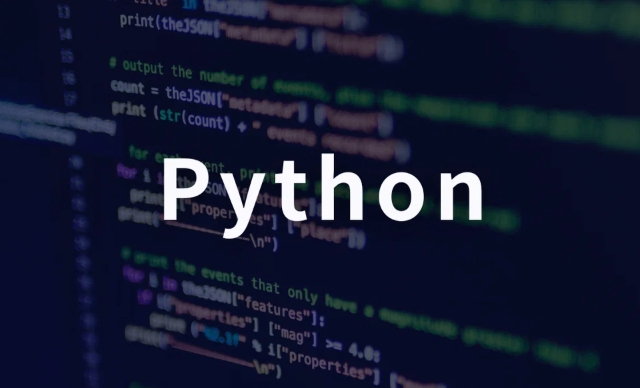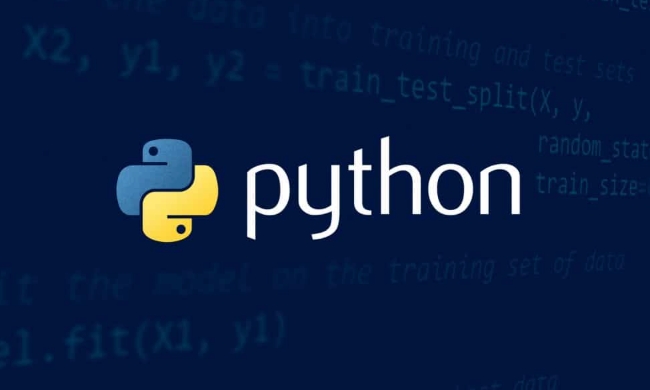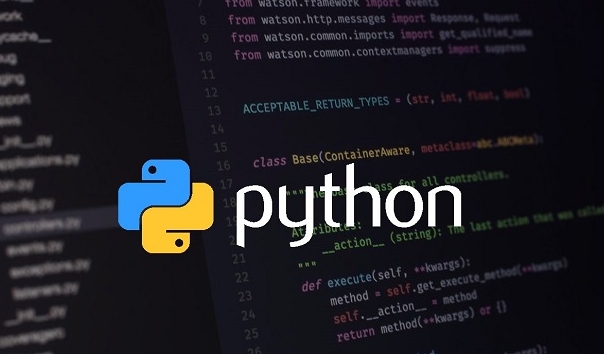 Backend Development
Backend Development
 Python Tutorial
Python Tutorial
 Getting Started with Asynchronous Programming in Python (asyncio)
Getting Started with Asynchronous Programming in Python (asyncio)
Getting Started with Asynchronous Programming in Python (asyncio)
Jul 06, 2025 am 02:48 AMAsynchronous programming is implemented in Python through asyncio, allowing programs to perform other tasks while waiting for the I/O operation to complete. Use async def to define coroutines and call other coroutines through await, avoiding the performance problems of traditional blocking programming. 1. asyncio.run() simplifies event loop management, automatically creates and cleanses event loops; 2. Use asyncio.gather() to run multiple tasks concurrently to improve efficiency; 3. In embedded environments such as Jupyter, asyncio.get_event_loop() is required to obtain the current event loop. Mastering these basics can you write efficient asynchronous Python code.

Asynchronous programming in Python might sound complex at first, but once you get the hang of it, it's a powerful way to write faster and more efficient code — especially for I/O-bound tasks like handling network requests or waiting for file operations.

If you're new to async programming, the main thing to understand is that asyncio lets your program do other work while waiting for something else to finish. That's different from traditional "blocking" code, where each step has to wait for the previous one to complete.

What Is async/await and Why Use It?
At the core of asyncio are two keywords: async and await . An async def function is called a coroutine, which doesn't run immediately when called — instead, it returns a coroutine object that needs to be awaited or scheduled.
You use await inside an async function to call another coroutine and wait for its result. This setup allows Python to pause the execution of that function and switch to doing something else while it waits.

Why bother? Because this model avoids creating multiple threads or processes, which can be heavy and complicated. Instead, everything runs within a single thread, managed by an event loop.
Here's a basic example:
import asyncio
async def says_hello():
print("Hello")
await asyncio.sleep(1)
print("World")
asyncio.run(say_hello())This script prints “Hello”, waits for one second without blocking the whole program, then prints “World”.
How to Run Async Code with asyncio.run()
Before Python 3.7, managing event loops was a bit messy — you had to create and manage them manually. But now, asyncio.run() handles all that for you. Just pass it your top-level coroutine, and it will set up the loop, run your code, and clean things up afterward.
It's the recommended way to start asynchronous programs unless you have specific reasons not to.
A few key points about asyncio.run() :
- It creates a new event loop every time it's called.
- It closes any resources properly after execution.
- Don't use it inside already running event loops — you'll get an error.
If you're using Jupyter notebooks or embedding async code inside another system, you may need to use await directly or access the current event loop via asyncio.get_event_loop() instead.
Structuring Concurrent Tasks with asyncio.gather()
Running one coroutine at a time isn't much faster than regular code. The real benefit comes when you run multiple coroutines concurrently.
To do that, asyncio.gather() is your go-to tool. It schedules multiple awaitable objects (like coroutines) and waits for all of them to finish.
Here's how you can run three tasks at once:
async def task(name):
print(f"{name} started")
await asyncio.sleep(2)
print(f"{name} finished")
async def main():
await asyncio.gather(
task("Task A"),
task("Task B"),
task("Task C")
)
asyncio.run(main())In this example, all three tasks start together. After about two seconds, they all finish. You'll see the "started" messages first, then a pause, then the "finished" ones.
A couple of tips:
- Make sure you
awaitthe result ofgather(), otherwise nothing will actually run. - If you're passing in coroutine objects, don't add parentses —
task()starts it;taskrefers to the function itself. - You can also gather results by capturing return values ??from your coroutines.
Wrapping Up
Getting started with asyncio doesn't have to be overwhelming. Start small with async def , await , and asyncio.run() , then move on to structuring concurrent workflows with asyncio.gather() .
Once you're comfortable with these basics, you can explore more advanced topics like async context managers, queues, or HTTP clients like aiohttp .
But for most beginners, the above covers what you need to start writing useful async Python code.
Basically that's it.
The above is the detailed content of Getting Started with Asynchronous Programming in Python (asyncio). For more information, please follow other related articles on the PHP Chinese website!

Hot AI Tools

Undress AI Tool
Undress images for free

Undresser.AI Undress
AI-powered app for creating realistic nude photos

AI Clothes Remover
Online AI tool for removing clothes from photos.

Clothoff.io
AI clothes remover

Video Face Swap
Swap faces in any video effortlessly with our completely free AI face swap tool!

Hot Article

Hot Tools

Notepad++7.3.1
Easy-to-use and free code editor

SublimeText3 Chinese version
Chinese version, very easy to use

Zend Studio 13.0.1
Powerful PHP integrated development environment

Dreamweaver CS6
Visual web development tools

SublimeText3 Mac version
God-level code editing software (SublimeText3)
 How to handle API authentication in Python
Jul 13, 2025 am 02:22 AM
How to handle API authentication in Python
Jul 13, 2025 am 02:22 AM
The key to dealing with API authentication is to understand and use the authentication method correctly. 1. APIKey is the simplest authentication method, usually placed in the request header or URL parameters; 2. BasicAuth uses username and password for Base64 encoding transmission, which is suitable for internal systems; 3. OAuth2 needs to obtain the token first through client_id and client_secret, and then bring the BearerToken in the request header; 4. In order to deal with the token expiration, the token management class can be encapsulated and automatically refreshed the token; in short, selecting the appropriate method according to the document and safely storing the key information is the key.
 Explain Python assertions.
Jul 07, 2025 am 12:14 AM
Explain Python assertions.
Jul 07, 2025 am 12:14 AM
Assert is an assertion tool used in Python for debugging, and throws an AssertionError when the condition is not met. Its syntax is assert condition plus optional error information, which is suitable for internal logic verification such as parameter checking, status confirmation, etc., but cannot be used for security or user input checking, and should be used in conjunction with clear prompt information. It is only available for auxiliary debugging in the development stage rather than substituting exception handling.
 What are python iterators?
Jul 08, 2025 am 02:56 AM
What are python iterators?
Jul 08, 2025 am 02:56 AM
InPython,iteratorsareobjectsthatallowloopingthroughcollectionsbyimplementing__iter__()and__next__().1)Iteratorsworkviatheiteratorprotocol,using__iter__()toreturntheiteratorand__next__()toretrievethenextitemuntilStopIterationisraised.2)Aniterable(like
 What are Python type hints?
Jul 07, 2025 am 02:55 AM
What are Python type hints?
Jul 07, 2025 am 02:55 AM
TypehintsinPythonsolvetheproblemofambiguityandpotentialbugsindynamicallytypedcodebyallowingdeveloperstospecifyexpectedtypes.Theyenhancereadability,enableearlybugdetection,andimprovetoolingsupport.Typehintsareaddedusingacolon(:)forvariablesandparamete
 How to iterate over two lists at once Python
Jul 09, 2025 am 01:13 AM
How to iterate over two lists at once Python
Jul 09, 2025 am 01:13 AM
A common method to traverse two lists simultaneously in Python is to use the zip() function, which will pair multiple lists in order and be the shortest; if the list length is inconsistent, you can use itertools.zip_longest() to be the longest and fill in the missing values; combined with enumerate(), you can get the index at the same time. 1.zip() is concise and practical, suitable for paired data iteration; 2.zip_longest() can fill in the default value when dealing with inconsistent lengths; 3.enumerate(zip()) can obtain indexes during traversal, meeting the needs of a variety of complex scenarios.
 Python FastAPI tutorial
Jul 12, 2025 am 02:42 AM
Python FastAPI tutorial
Jul 12, 2025 am 02:42 AM
To create modern and efficient APIs using Python, FastAPI is recommended; it is based on standard Python type prompts and can automatically generate documents, with excellent performance. After installing FastAPI and ASGI server uvicorn, you can write interface code. By defining routes, writing processing functions, and returning data, APIs can be quickly built. FastAPI supports a variety of HTTP methods and provides automatically generated SwaggerUI and ReDoc documentation systems. URL parameters can be captured through path definition, while query parameters can be implemented by setting default values ??for function parameters. The rational use of Pydantic models can help improve development efficiency and accuracy.
 How to test an API with Python
Jul 12, 2025 am 02:47 AM
How to test an API with Python
Jul 12, 2025 am 02:47 AM
To test the API, you need to use Python's Requests library. The steps are to install the library, send requests, verify responses, set timeouts and retry. First, install the library through pipinstallrequests; then use requests.get() or requests.post() and other methods to send GET or POST requests; then check response.status_code and response.json() to ensure that the return result is in compliance with expectations; finally, add timeout parameters to set the timeout time, and combine the retrying library to achieve automatic retry to enhance stability.
 Setting Up and Using Python Virtual Environments
Jul 06, 2025 am 02:56 AM
Setting Up and Using Python Virtual Environments
Jul 06, 2025 am 02:56 AM
A virtual environment can isolate the dependencies of different projects. Created using Python's own venv module, the command is python-mvenvenv; activation method: Windows uses env\Scripts\activate, macOS/Linux uses sourceenv/bin/activate; installation package uses pipinstall, use pipfreeze>requirements.txt to generate requirements files, and use pipinstall-rrequirements.txt to restore the environment; precautions include not submitting to Git, reactivate each time the new terminal is opened, and automatic identification and switching can be used by IDE.





